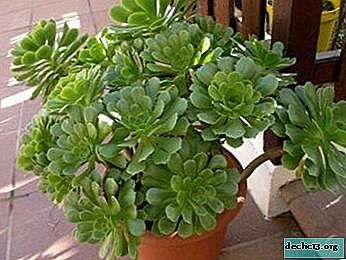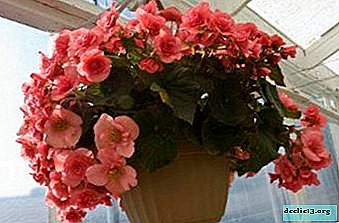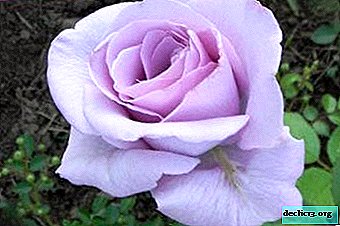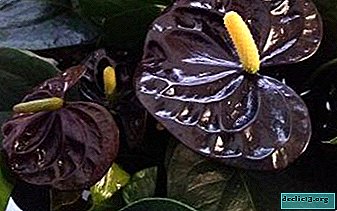Basic rules for the care and cultivation of Floribunda roses
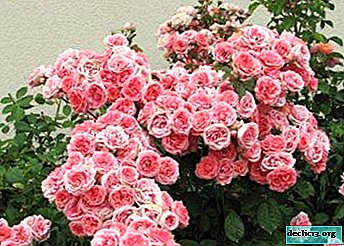
Rosa floribunda is a hybrid group of varieties, bred at the beginning of the twentieth century in parallel on different continents by Danish breeder Sven Poulsen and American P. Lambert, by crossing a tea-hybrid rose with a polyanthus. The name of the plant translates as "abundantly blooming rose" for the lush and continuous flowering of the bush.
In the group there are border, medium and high grades. In the article you will find a description of how to care for flowers, see their photos.
The importance of proper content
Despite the fact that floribunda is considered one of the most undemanding types of roses in care, it appearance is determined by the correct, timely and careful attitude to growing. Experienced gardeners call the pruning of a bush and timely top-dressing the most important part of caring for floribunda.
Photo
Below you will see a photo of the flower:





Features of the content, unlike other varieties
Unlike other varieties of roses, floribunda:
- resistant to frost;
- has immunity against diseases;
- has a wide range of shades (there are two-tone and many-colored varieties);
- the flowers on the shoots are not located individually, but in inflorescences of various sizes, resembling brushes;
- differs in wavy flowering;
- has straight and straight spikes;
- no plaque is observed on the leaf plate;
- flowers do not need to be cut, they fall on their own;
- practically does not smell (some varieties have a faint aroma).
How to care?
Depending on the season
Depending on the season, the need for top dressing, abundance of watering and pruning of the bush differs. In the fall, sanitary pruning is carried out. Before the winter period, the rose is cut to the size of a shelter, spud and fed with organic fertilizers for a more comfortable wintering; watering stops.
In the spring, after removing the shelter, thickened bushes are thinned out, old shoots are removed and the bush begins to actively feed and water. In summer, active growth of the plant begins, which produces young shoots that need a little pruning, plenty of moisture and fertilizing with various fertilizers.
From flowering plants
 From the end of spring to the beginning of flowering in August, the most active care of the plant occurs. This is due to the fact that floribunda immediately gives a lot of flowers, the production of which consumes significant resources of the bush.
From the end of spring to the beginning of flowering in August, the most active care of the plant occurs. This is due to the fact that floribunda immediately gives a lot of flowers, the production of which consumes significant resources of the bush.
During flowering, care is minimized - moderate watering. When the flowering ends in late autumn, the floribunda must be prepared for winter "hibernation": pruning and sheltering the bushes.
Step-by-step instruction for beginners
First steps after purchase
Purchased rose seedlings can be purchased in winter and kept in a dark, cool place (+ 1-5 C), where they can “sleep” without any care until the end of spring (May-early June), i.e. time of landing in open ground.
When buying, you need to pay attention so that there are no greenery on the branches! If the first young leaves began to hatch on the seedlings, the sprouts should be urgently planted in temporary soil in a pot, otherwise they will die.
Soil preparation
Non-acidic, well-drained soil is suitable for floribunda. If clay soil prevails in the area, it should first be diluted with compost and river sand, with the addition of superphosphate fertilizer and bone meal. Similarly, if the soil is sandy, the same components are added to it, plus clay soil and humus for thickening the soil. The earth must be prepared in advance (20-30 days before disembarkation), so that all components have time to mix well and the earth settles.
Attention! The plant is not recommended to be planted in wetlands and lowlands where meltwater can accumulate.Choosing a place in the garden
 Floribunda is a light-loving plant, but sensitive to direct sunlight.
Floribunda is a light-loving plant, but sensitive to direct sunlight.
For landing, the southwest, southeast side is suitable, which will be bright half of the day, and in the second the bushes will be in light shading.
Also, the place should not be much blown, since the rose does not tolerate drafts.
Rose Floribunda looks very impressive as a hedge or decoration of arbors.
Watering
Floribunda loves water, however rose's water demand varies with the season:
- in spring - plentiful (10 liters of water per bush), once a week;
- in summer - plentiful, 2 times a week;
- in autumn - less than 1 time in 2 weeks (depending on the amount of natural precipitation);
- in winter - watering stops.
Water for irrigation should be soft and settled. It is not recommended to water the bushes during the day in the heat, it is better to make the liquid in the morning or in the evening.
Top dressing
Experienced gardeners alternate fertilizing with organic and mineral fertilizers. As a top dressing use: mullein with compost and humus, ammonium nitrate, potassium and urea. The first top dressing is introduced 2 weeks after the opening of the first leaves. In the phase of active growth, the floribunda requires 2-3 repeated feeding (one of which may be nitrogen). In autumn, one feeding with potassium salt and superphosphate is allowed.
Important! In the first year after planting, the bush does not fertilize with anything.Lighting
The ideal lighting for a rose is the abundance of light without direct sunlight directly on the bush.
Temperature
Floribunda - a hybrid species that is well adapted to temperature fluctuations and resistant to subzero temperatures. In central Russia, the plant feels great.
Humidity
Rose loves moisture, but you should avoid excessive moisture and stagnation of fluid in the soil. With excess moisture, the plant can become sick and die.
Spraying
Floribunda loves spraying leaves and flowers from a spray bottle, which is carried out with the same frequency and according to the same rules as watering. In spring, additional shoots are sprayed with a light solution of copper sulfate and Bordeaux fluid to prevent the development of diseases.
Transfer
It is important for beginners to know that floribunda transplantation is carried out in two cases: the initial planting in open ground from a pot and in case the plant does not take root in the selected area.
Stages of the procedure: 
- in the prepared soil, a hole is dug with a depth and width of 40-50 cm;
- the pit is moistened with plenty of water;
- the roots of the bush are straightened, slightly shortened by secateurs and treated with a phytohormonal drug for better rooting;
- the seedling is placed vertically in the center of the pit and is covered with soil mixture;
- the buried bush is abundantly watered with water and sprinkled with sawdust for a longer preservation of moisture.
If there are vaccinations on the stems, they need to be immersed in the soil 2-3 cm for better rooting and the appearance of additional roots.
Spring pruning
Trimming is done immediately after removing the shelter. If the branches are weakened, strong pruning is performed (1-2 buds are left), if the branches are healthy, then medium or weak (4 to 8 buds are left).
Trimming Rules:
- only strong shoots are left on the bush;
- all damaged and frozen shoots must be removed;
- healthy branches are cut depending on the varietal height of the bush (an average of 25-35 cm);
- if the process is directed inward, it is removed, since it does not form the crown of the bush; leave only buds from the outer edge of the branch.
Preparation for winter
At the end of September, pre-winter top dressing with superphosphate and potassium salt is carried out. In October, watering, spraying and top dressing of bushes ceased. Before the onset of frost, it is necessary to remove all unripe buds, leaves and flowers.
Shelter for the winter
Immediately before shelter, you need to carry out the following procedures:
- trim bushes (tall varieties up to 35-40 cm, undersized to half);
- treat the stems with Bordeaux liquid;
- fill the bush with soil or peat at 20-30 cm;
- cover the plant with natural materials (fir spruce branches or oak leaves);
- cover with non-woven material, tightly fastening it or overlaying with stones.

The consequences of improper cultivation
If the plant is not properly looked after, it can be prone to diseases and pests:
- rust;
- powdery mildew;
- black spotting;
- aphids.
If the first symptoms occur, remove diseased or diseased shoots. and spray chemicals with all available bushes.
Due to the duration of flowering, frost and disease resistance and lush flowering, the floribunda is currently in great demand in garden and landscape design. Her beautiful flowers, characterized by a variety of colors and elegant simplicity of form, captivate both beginners and experienced gardeners and collectors.


